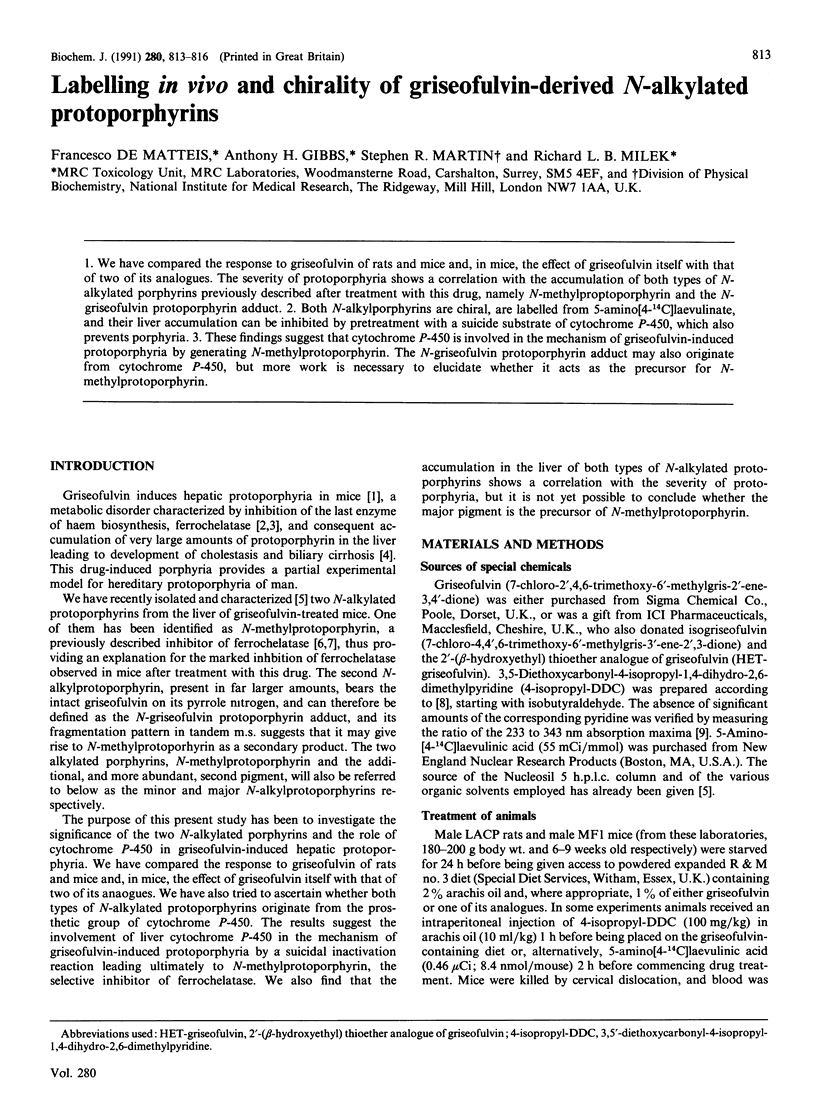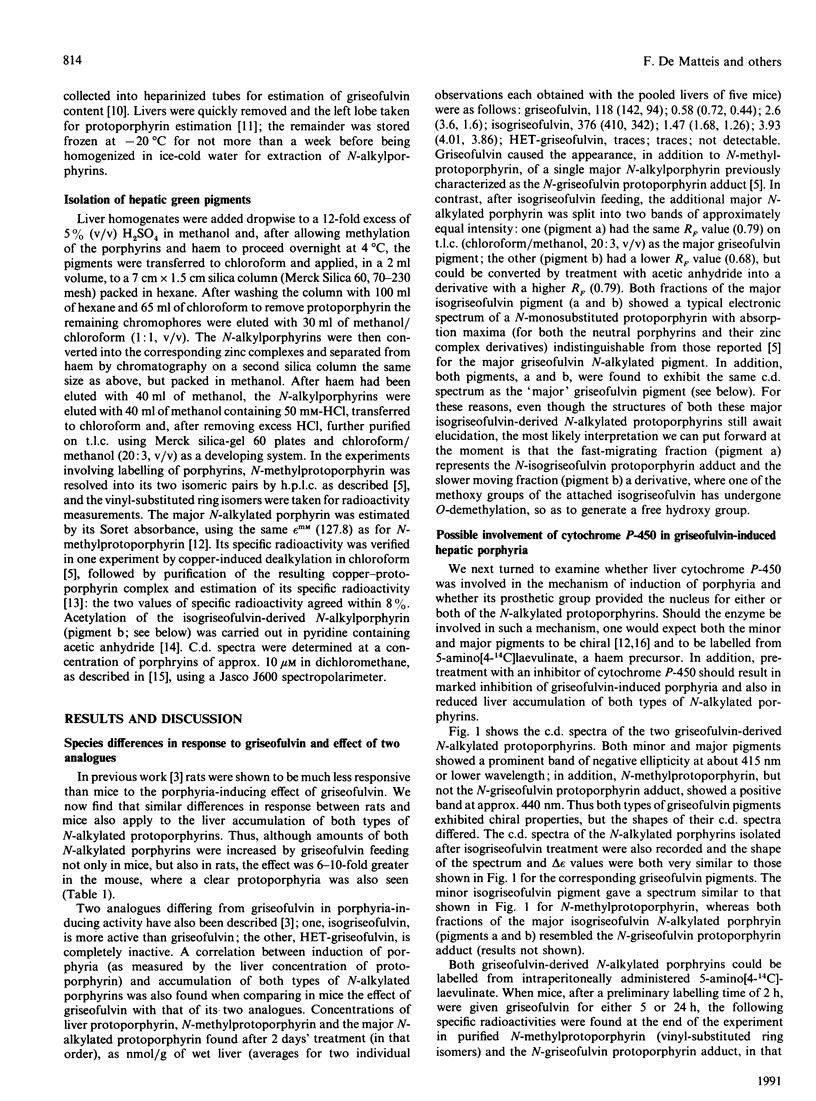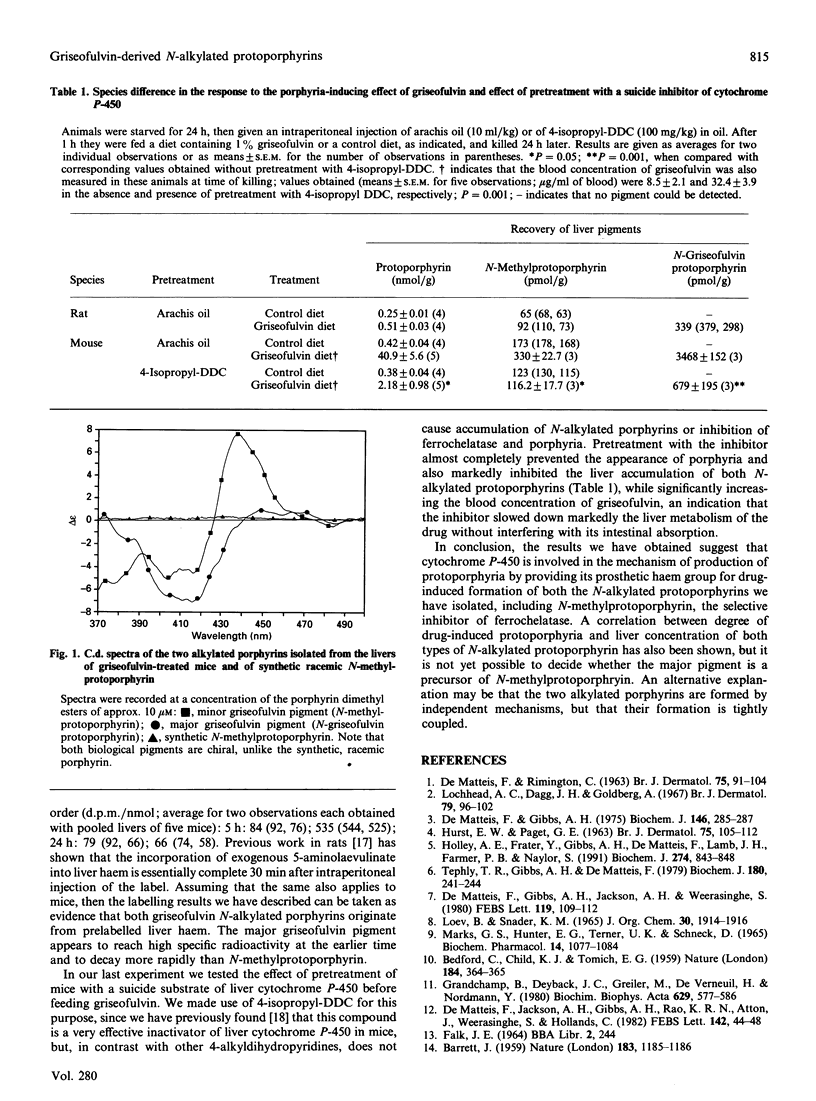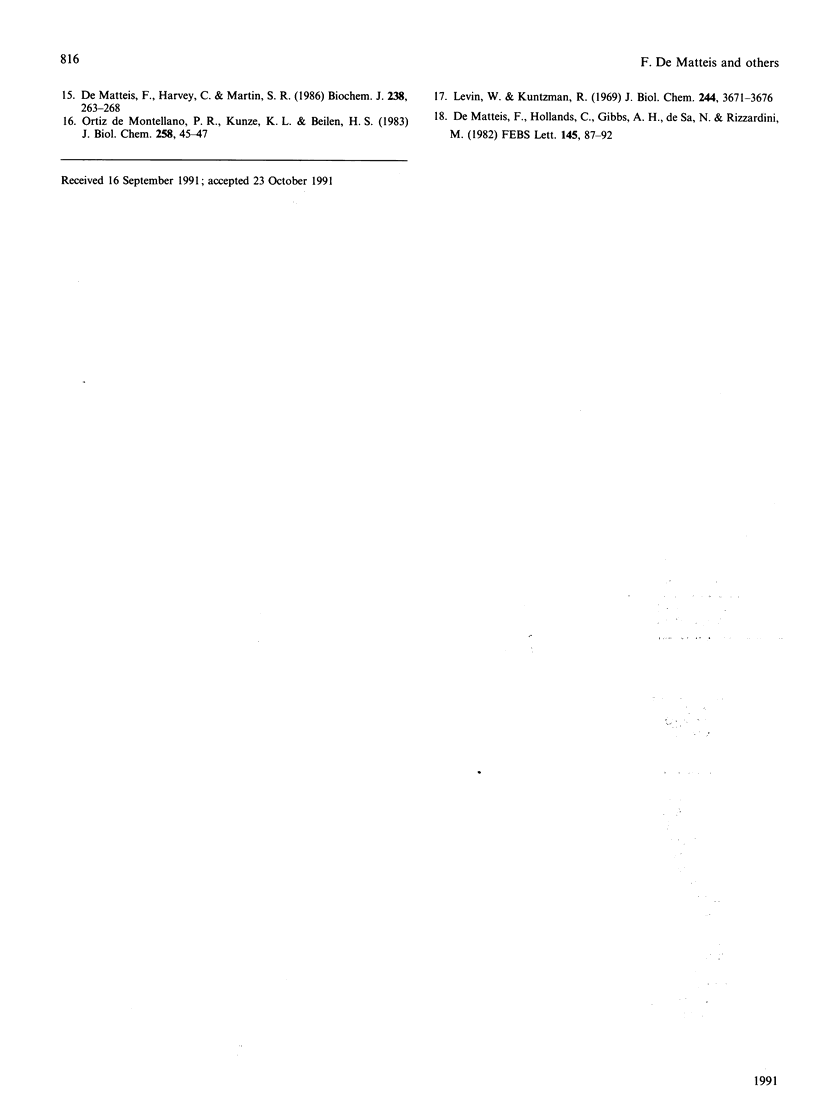Abstract
1. We have compared the response to griseofulvin of rats and mice and, in mice, the effect of griseofulvin itself with that of two of its analogues. The severity of protoporphyria shows a correlation with the accumulation of both types of N-alkylated porphyrins previously described after treatment with this drug, namely N-methylproptoporphyrin and the N-griseofulvin protoporphyrin adduct. 2. Both N-alkylporphyrins are chiral, are labelled from 5-amino[4-14C]laevulinate, and their liver accumulation can be inhibited by pretreatment with a suicide substrate of cytochrome P-450, which also prevents porphyria. 3. These findings suggest that cytochrome P-450 is involved in the mechanism of griseofulvin-induced protoporphyria by generating N-methylprotoporphyrin. The N-griseofulvin protoporphyrin adduct may also originate from cytochrome P-450, but more work is necessary to elucidate whether it acts as the precursor for N-methylprotoporphyrin.
Full text
PDF



Selected References
These references are in PubMed. This may not be the complete list of references from this article.
- BARRETT J. Detection of hydroxyl groups in porphyrins and chlorins. Nature. 1959 Apr 25;183(4669):1185–1186. doi: 10.1038/1831185a0. [DOI] [PubMed] [Google Scholar]
- BEDFORD C., CHILD K. J., TOMICH E. G. Spectrophotofluorometric assay of griseofulvin. Nature. 1959 Aug 1;184(Suppl 6):364–365. doi: 10.1038/184364a0. [DOI] [PubMed] [Google Scholar]
- DE MATTEIS F., RIMINGTON C. Disturbance of porphyrin metabolism caused by griseofulvin in mice. Br J Dermatol. 1963 Mar;75:91–104. doi: 10.1111/j.1365-2133.1963.tb13945.x. [DOI] [PubMed] [Google Scholar]
- De Matteis F., Gibbs A. H. Stimulation of the pathway of porphyrin synthesis in the liver of rats and mice by griseofulvin, 3,5-Diethoxycarbonyl-1,4-dihydrocollidine and related drugs: evidence for two basically different mechanisms. Biochem J. 1975 Jan;146(1):285–287. doi: 10.1042/bj1460285. [DOI] [PMC free article] [PubMed] [Google Scholar]
- De Matteis F., Harvey C., Martin S. R. N-alkylation of exogenous haem analogues caused by drugs in isolated hepatocytes. Structural isomerism and chirality of the resulting porphyrins. Biochem J. 1986 Aug 15;238(1):263–268. doi: 10.1042/bj2380263. [DOI] [PMC free article] [PubMed] [Google Scholar]
- De Matteis F., Jackson A. H., Gibbs A. H., Rao K. R., Atton J., Weerasinghe S., Hollands C. Structural isomerism and chirality of N-monosubstituted protoporphyrins. FEBS Lett. 1982 Jun 1;142(1):44–48. doi: 10.1016/0014-5793(82)80216-0. [DOI] [PubMed] [Google Scholar]
- Grandchamp B., Deybach J. C., Grelier M., de Verneuil H., Nordmann Y. Studies of porphyrin synthesis in fibroblasts of patients with congenital erythropoietic porphyria and one patient with homozygous coproporphyria. Biochim Biophys Acta. 1980 May 22;629(3):577–586. doi: 10.1016/0304-4165(80)90163-4. [DOI] [PubMed] [Google Scholar]
- Holley A. E., Frater Y., Gibbs A. H., De Matteis F., Lamb J. H., Farmer P. B., Naylor S. Isolation of two N-monosubstituted protoporphyrins, bearing either the whole drug or a methyl group on the pyrrole nitrogen atom, from liver of mice given griseofulvin. Biochem J. 1991 Mar 15;274(Pt 3):843–848. doi: 10.1042/bj2740843. [DOI] [PMC free article] [PubMed] [Google Scholar]
- Levin W., Kuntzman R. Biphasic decrease of radioactive hemoprotein from liver microsomal CO-binding particles. Effect of 3-methylcholanthrene. J Biol Chem. 1969 Jul 10;244(13):3671–3676. [PubMed] [Google Scholar]
- Lochhead A. C., Dagg J. H., Goldberg A. Experimental griseofulvin porphyria in adult and foetal mice. Br J Dermatol. 1967 Feb;79(2):96–102. doi: 10.1111/j.1365-2133.1967.tb11463.x. [DOI] [PubMed] [Google Scholar]
- Marks G. S., Hunter E. G., Terner U. K., Schneck D. Studies of the relationship between chemical structure and porphyria-inducing activity. Biochem Pharmacol. 1965 Jul;14(7):1077–1084. doi: 10.1016/0006-2952(65)90037-7. [DOI] [PubMed] [Google Scholar]
- Ortiz de Montellano P. R., Kunze K. L., Beilan H. S. Chiral orientation of prosthetic heme in the cytochrome P-450 active site. J Biol Chem. 1983 Jan 10;258(1):45–47. [PubMed] [Google Scholar]
- Tephly T. R., Gibbs A. H., De Matteis F. Studies on the mechanism of experimental porphyria produced by 3,5-diethoxycarbonyl-1,4-dihydrocollidine. Role of a porphyrin-like inhibitor of protohaem ferro-lyase. Biochem J. 1979 Apr 15;180(1):241–244. doi: 10.1042/bj1800241. [DOI] [PMC free article] [PubMed] [Google Scholar]
- de Matteis F., Gibbs A. H., Jackson A. H., Weerasinghe S. Conversion of liver haem into N-substituted porphyrins or green pigments. Nature of the substituent at the pyrrole nitrogen atom. FEBS Lett. 1980 Sep 22;119(1):109–112. doi: 10.1016/0014-5793(80)81009-x. [DOI] [PubMed] [Google Scholar]
- de Matteis F., Hollands C., Gibbs A. H., de Sa N., Rizzardini M. Inactivation of cytochrome P-450 and production of N-alkylated porphyrins caused in isolated hepatocytes by substituted dihydropyridines. Structural requirements for loss of haem and alkylation of the pyrrole nitrogen atom. FEBS Lett. 1982 Aug 16;145(1):87–92. doi: 10.1016/0014-5793(82)81212-x. [DOI] [PubMed] [Google Scholar]


